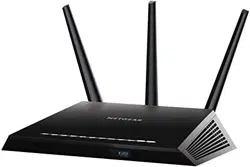Loading ...
Loading ...
Loading ...

Specify Your Internet Settings
31
Nighthawk AC1900 Smart WiFi Router
• Get Automatically from ISP. Your ISP uses DHCP to assign your DNS servers. Your
ISP automatically assigns this address.
• Use These DNS Servers. If you know that your ISP requires specific servers, select
this option. Enter the IP address of your ISP’s primary DNS server. If a secondary
DNS server address is available, enter it also.
7. (Optional) In the DHCP User Class (If Required) field, enter a host name.
Most people can leave this field blank, but if your ISP has given you a specific host name,
enter it here.
8. (Optional) In the DHCP Domain Name (If Required) field, enter a domain name.
You can type the domain name of your IPv6 ISP. Do not enter the domain name for the
IPv4 ISP here. For example, if your ISP’s mail server is mail.xxx.yyy.zzz, type xxx.yyy.zzz
as the domain name. If your ISP provided a domain name, type it in this field. For
example, Earthlink Cable might require a host name of home, and Comcast sometimes
supplies a domain name.
9. Specify how the router assigns IPv6 addresses to the devices on your home network (the
LAN) by selecting one of the following radio buttons:
• Use DHCP Server. This method passes more information to LAN devices, but some
IPv6 systems might not support the DHCv6 client function.
• Auto Config. This is the default setting.
10. (Optional) Select the Use This Interface ID check box and specify the interface ID that you
want to be used for the IPv6 address of the router’s LAN interface.
If you do not specify an ID here, the router generates one automatically from its MAC
address.
11. Click the Apply button.
Your settings are saved.
Set Up an IPv6 6rd Tunnel Internet Connection
6rd protocol makes it possible to deploy IPv6 to sites using a service provider's IPv4 network.
6rd uses the service provider’s own IPv6 address prefix. This limits the operational domain of
6rd to the service provider’s network and is under direct control of the service provider. The
IPv6 service provided is equivalent to native IPv6.
The 6rd mechanism relies upon an algorithmic mapping between the IPv6 and IPv4
addresses that are assigned for use within the service provider’s network. This mapping
allows for automatic determination of IPv4 tunnel endpoints from IPv6 prefixes, allowing
stateless operation of 6rd.
With a 6rd Tunnel configuration, the router follows the RFC5969 standard, supporting two
ways to establish a 6rd tunnel IPv6 WAN connection.
• Auto Mode. In IPv6 Auto Detect mode, when the router receives option 212 from the
DHCPv4 option, auto detect selects the IPv6 as 6rd Tunnel setting. The router uses the
6rd option information to establish the 6rd connection.
Loading ...
Loading ...
Loading ...
